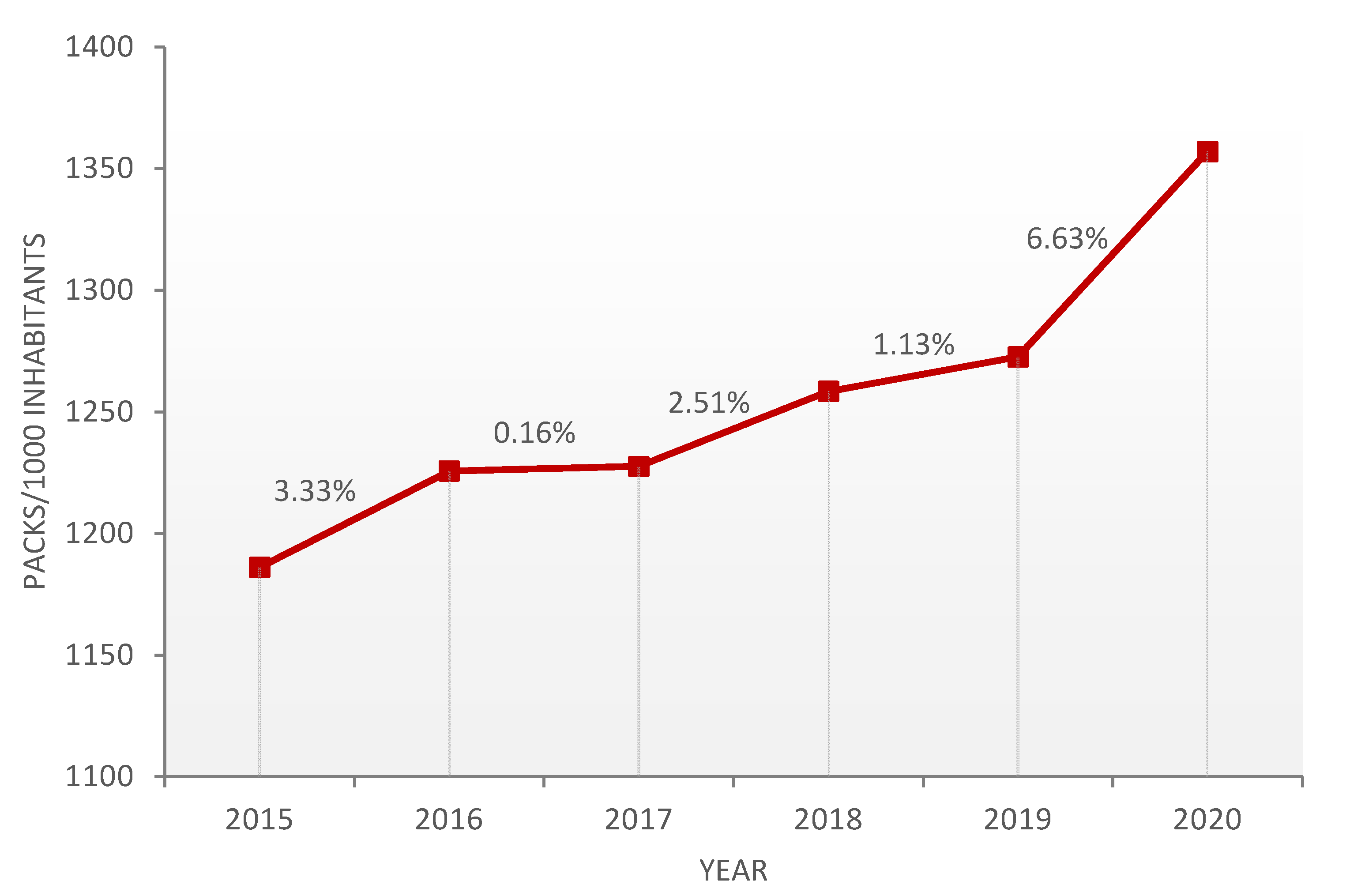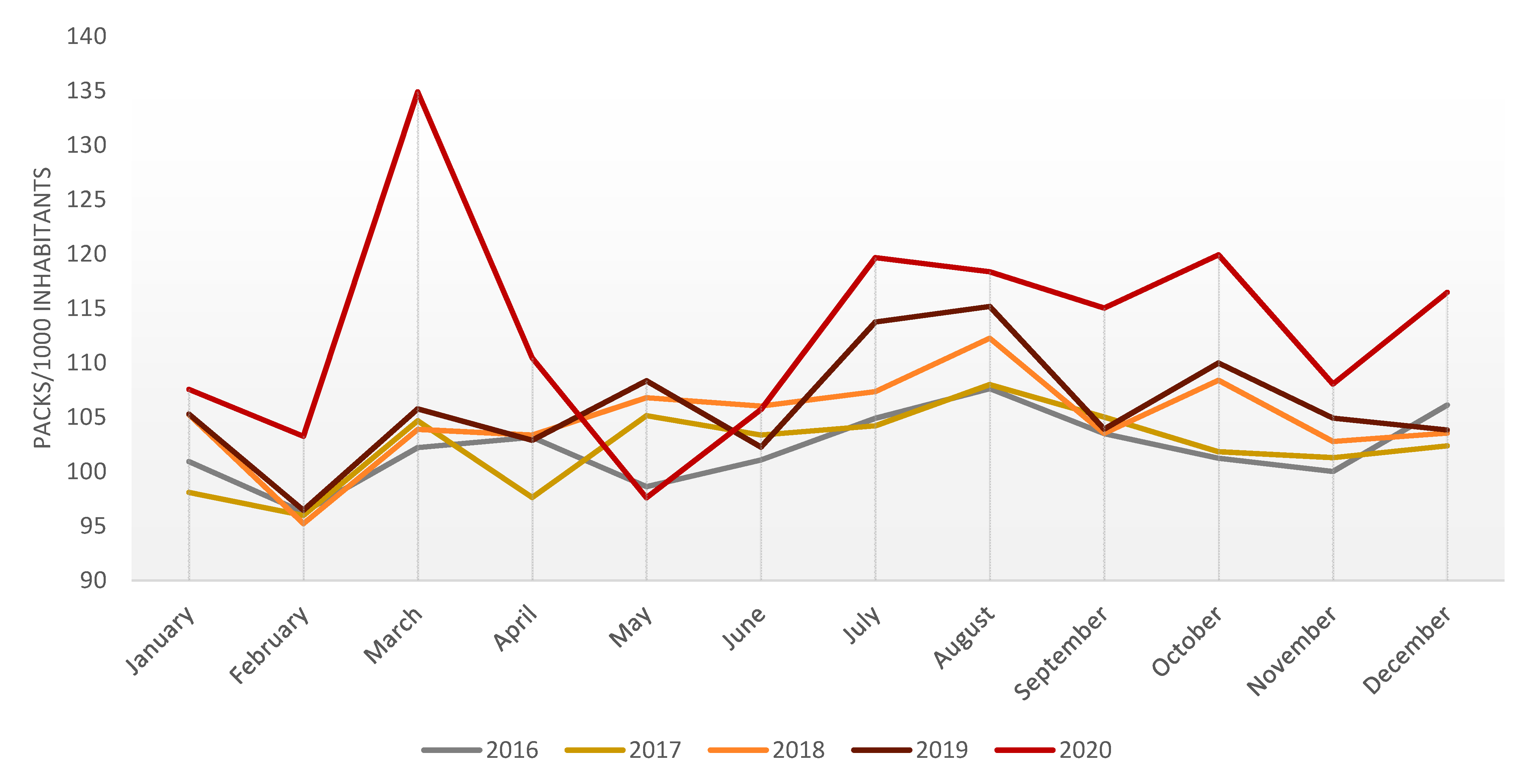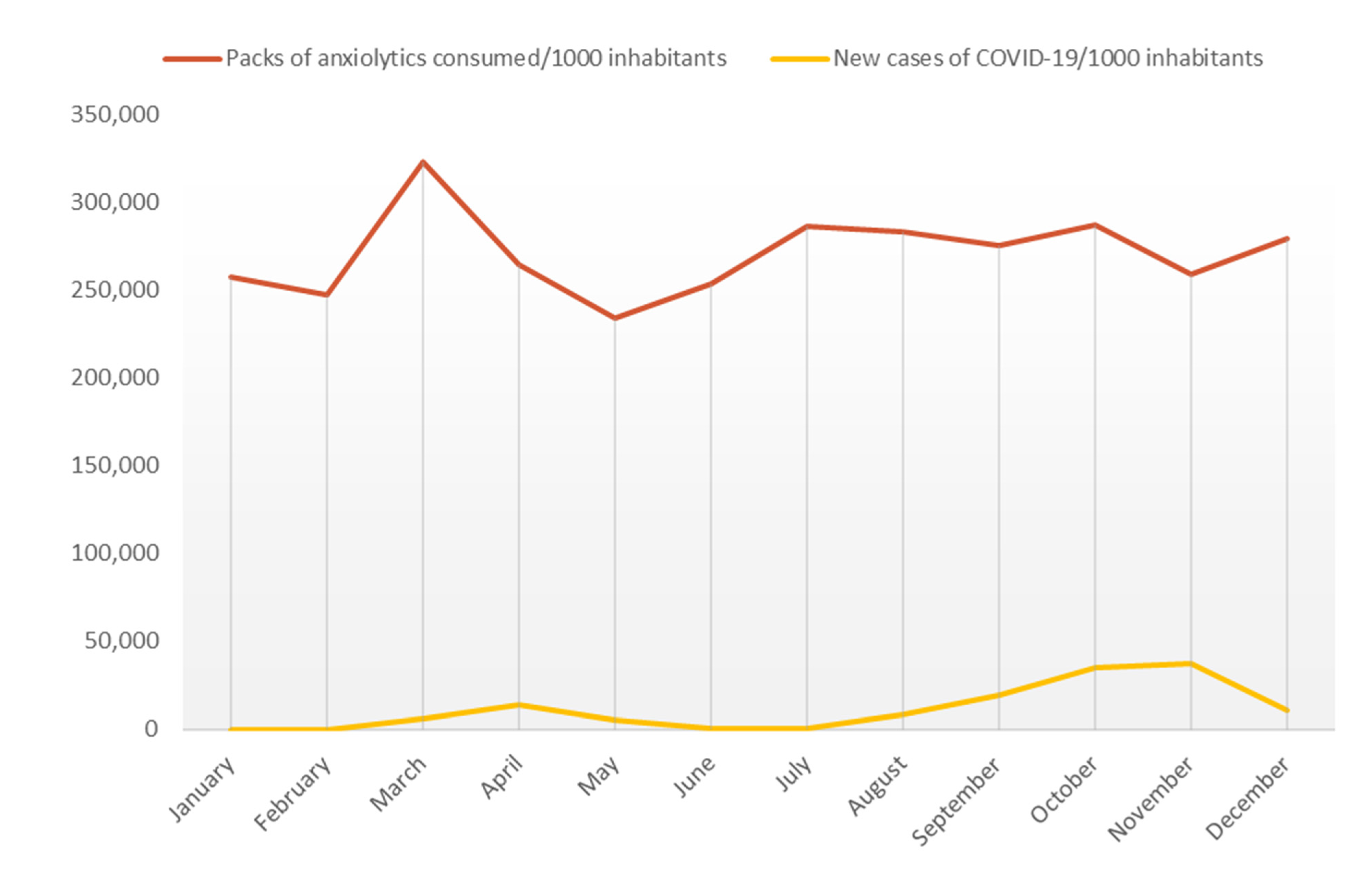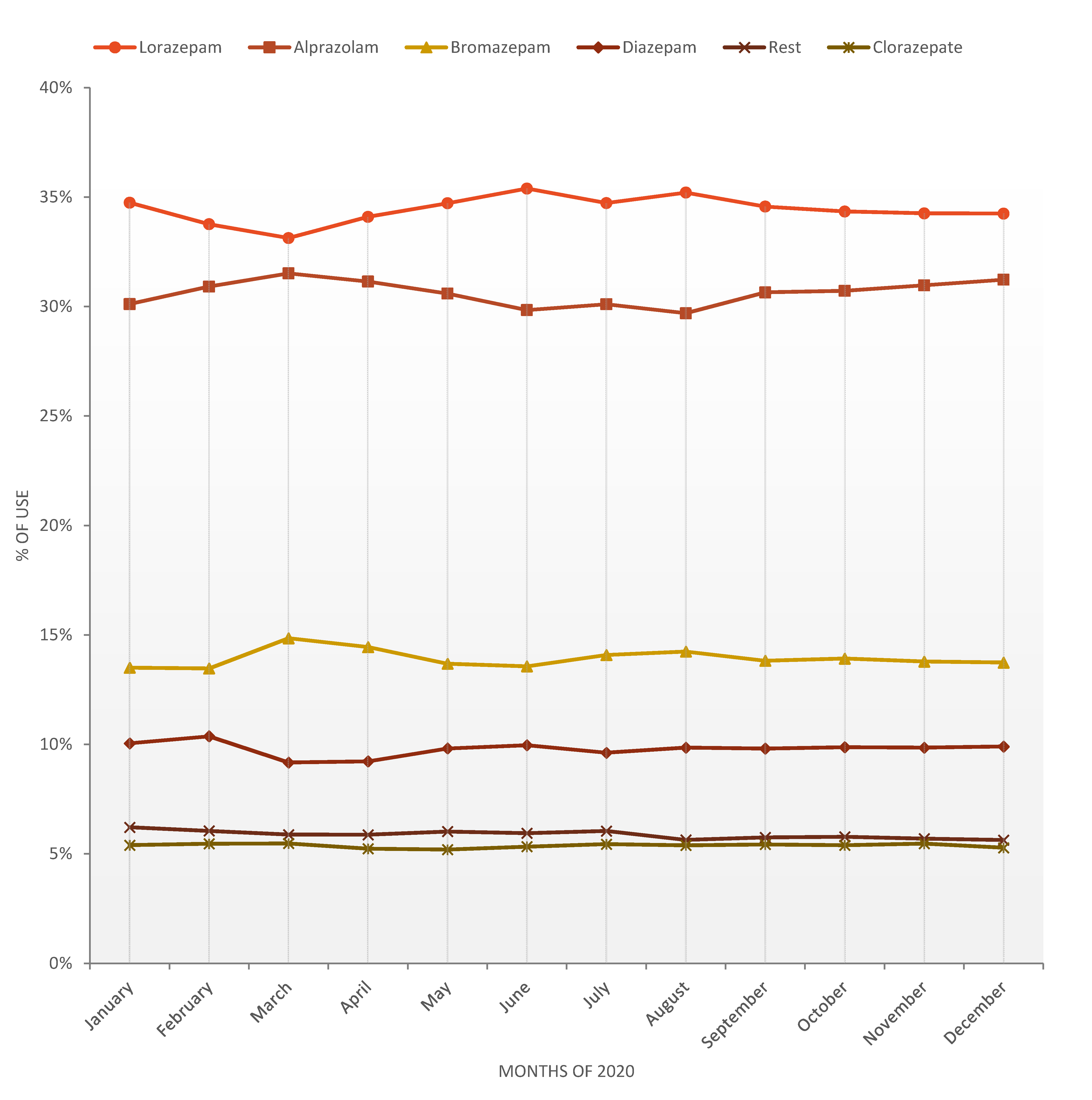Trends in the Use of Anxiolytics in Castile and Leon, Spain, between 2015–2020: Evaluating the Impact of COVID-19
Abstract
:1. Introduction
2. Materials and Methods
3. Results
4. Discussion
5. Conclusions
Author Contributions
Funding
Institutional Review Board Statement
Informed Consent Statement
Data Availability Statement
Acknowledgments
Conflicts of Interest
References
- WHO Regional Office for Europe. European Mental Health Action Plan 2013–2020; WHO Regional Office for Europe: København, Denmark, 2015. [Google Scholar]
- AEMPS. Observatory of Drug Use. Use of Anxiolytic and Hypnotic Drugs in Spain during the Period 2010–2018. Available online: https://www.aemps.gob.es/medicamentos-de-uso-humano/observatorio-de-uso-de-medicamentos/informes-ansioliticos-hipnoticos-espana-2010–2018/ (accessed on 20 April 2021).
- Simó, J. Drug use in Spain and Europe. Prim. Care 2012, 44, 335–347. [Google Scholar]
- Vicente, M.P.; Macías, D.; de la Fuente, C.; González, D.; Montero, D.; Catalá-López, F. Evolution of the use of anxiolytic and hypnotic drugs in Spain during the period 2000–2011. Span. Mag. Public Health 2013, 87, 247–255. [Google Scholar]
- National Health Survey ENSE, Spain 2017. Ministry of Health, Consumption and Social Welfare. Available online: https://www.mscbs.gob.es/estadEstudios/estadisticas/encuestaNacional/encuestaNac2017/SALUD_MENTAL.pdf (accessed on 2 December 2020).
- Pharmaceutical Benefit in the National Health System. Annual Report of the National Health System 2018. Reports, Studies and Research 2020. Ministry of Health, Consumption and Social Welfare. Available online: https://www.mscbs.gob.es/estadEstudios/estadisticas/sisInfSanSNS/tablasEstadisticas/InfAnualSNS2018/Cap.7_Farmacia.pdf (accessed on 20 November 2020).
- Panes, A.; Pariente, A.; Bénard-Laribière, A.; Lassalle, R.; Dureau-Pournin, C.; Lorrain, S.; Tournier, M.; Fourrier-Réglat, A. Use of benzodiazepines and z-drugs not compliant with guidelines and associated factors: A population-based study. Eur. Arch. Psychiatry Clin. Neurosci. 2020, 270, 3–10. [Google Scholar] [CrossRef] [PubMed]
- Donoghue, J.; Lader, M. Usage of benzodiazepines: A review. Int. J. Psychiatry Clin. Pract. 2010, 14, 78–87. [Google Scholar] [CrossRef] [PubMed]
- AEMPS. Observatory of Drug Use. Use of Benzodiazepines in Spain (1992–2006). Available online: https://www.aemps.gob.es/medicamentosUsoHumano/observatorio/docs/ansioliticos_hipnoticos.pdf (accessed on 16 November 2020).
- García, J.; de Abajo, F.J.; Carvajal, A.; Montero, D.; Madurga, M.; García, V. Use of anxiolytic and hypnotic drugs in Spain (1995–2002). Span. Mag. Public Health 2004, 78, 379–387. [Google Scholar]
- Statistics National Institute. Demography and Population. Castile and Leon Register. Available online: https://www.ine.es/jaxiT3/Tabla.htm?t=2915&L=0 (accessed on 18 April 2021).
- Coronavirus Epidemiological Situation (COVID-19) in Castile and Leon. Available online: https://analisis.datosabiertos.jcyl.es/explore/dataset/situacion-epidemiologica-coronavirus-en-castilla-y-leon/table/?disjunctive.provincia&sort=-fecha&refine.fecha=2020&dataChart=eyJxdWVyaWVzIjpbeyJjaGFydHMiOlt7InR5cGUiOiJjb2x1bW4iLCJmdW5jIjoiQ09VTlQiLCJ5QXhpcyI6ImNhc29zX2NvbmZpcm1hZG9zIiwic2NpZW50aWZpY0Rpc3BsYXkiOnRydWUsImNvbG9yIjoicmFuZ2UtQWNjZW50In1dLCJ4QXhpcyI6ImZlY2hhIiwibWF4cG9pbnRzIjpudWxsLCJ0aW1lc2NhbGUiOiJ5ZWFyIiwic29ydCI6IiIsImNvbmZpZyI6eyJkYXRhc2V0Ijoic2l0dWFjaW9uLWVwaWRlbWlvbG9naWNhLWNvcm9uYXZpcnVzLWVuLWNhc3RpbGxhLXktbGVvbiIsIm9wdGlvbnMiOnsiZGlzanVuY3RpdmUucHJvdmluY2lhIjp0cnVlLCJzb3J0IjoiLWZlY2hhIiwicmVmaW5lLmZlY2hhIjoiMjAyMCIsImxvY2F0aW9uIjoiOCw0MS42NDk1NCwtNC4zMzMzMyIsImJhc2VtYXAiOiJqYXdnLnN0cmVldHMifX0sInNlcmllc0JyZWFrZG93biI6ImZhbGxlY2ltaWVudG9zIiwic2VyaWVzQnJlYWtkb3duVGltZXNjYWxlIjoiIiwic3RhY2tlZCI6IiJ9XSwiZGlzcGxheUxlZ2VuZCI6dHJ1ZSwiYWxpZ25Nb250aCI6dHJ1ZSwidGltZXNjYWxlIjoiIiwic2luZ2xlQXhpcyI6ZmFsc2V9&location=8,41.64954,-4.33333&basemap=jawg.streets (accessed on 21 April 2021).
- Vademecum. Lorazepam. Available online: https://www.vademecum.es/principios-activos-lorazepam-N05BA06 (accessed on 17 December 2020).
- Vademecum. Alprazolam. Available online: https://www.vademecum.es/principios-activos-alprazolam-N05BA12 (accessed on 17 December 2020).
- Vademecum. Bromazepam. Available online: https://www.vademecum.es/principios-activos-bromazepam-N05BA08 (accessed on 17 December 2020).
- Vademecum. Diazepam. Available online: https://www.vademecum.es/principios-activos-diazepam-N05BA01 (accessed on 17 December 2020).
- Vademecum. Clorazepate. Available online: https://www.vademecum.es/principios-activos-clorazepato+de+potasio-N05BA05 (accessed on 17 December 2020).
- Anderson, R.M.; Heesterbeek, H.; Klinkenberg, D.; Hollingsworth, T.D. How will country-based mitigation measures influence the course of the COVID-19 epidemic? Lancet 2020, 395, 931–934. [Google Scholar] [CrossRef]
- Salari, N.; Hosseinian-Far, A.; Jalali, R.; Vaisi-Raygani, A.; Rasoulpoor, S.; Mohammadi, M.; Rasoulpoor, S.; Khaledi-Paveh, B. Prevalence of stress, anxiety, depression among the general population during the COVID-19 pandemic: A systematic review and meta-analysis. Glob. Health 2020, 16, 57. [Google Scholar] [CrossRef] [PubMed]
- Pera, A. Cognitive, Behavioral, and Emotional Disorders in Populations Affected by the COVID-19 Outbreak. Front. Psychol. 2020, 11, 2263. [Google Scholar] [CrossRef] [PubMed]
- Holmes, E.A.; O’Connor, R.C.; Perry, V.H.; Tracey, I.; Wessely, S.; Arseneault, L.; Ballard, C.; Christensen, H.; Cohen Silver, R.; Everall, I.; et al. Multidisciplinary research priorities for the COVID-19 pandemic: A call for action for mental health science. Lancet Psychiatry 2020, 7, 547–560. [Google Scholar] [CrossRef]
- Liu, J.J.; Bao, Y.; Huang, X.; Shi, J.; Lu, L. Mental health considerations for children quarantined because of COVID-19. Lancet Child. Adolesc. Health 2020, 4, 347–349. [Google Scholar] [CrossRef] [Green Version]
- Otu, A.; Charles, C.H.; Yaya, S. Mental health and psychosocial well-being during the COVID-19 pandemic: The invisible elephant in the room. Int. J. Ment. Health Syst. 2020, 14, 38. [Google Scholar] [CrossRef] [PubMed]
- Vieta, E.; Pérez, V.; Arango, C. Psychiatry in the aftermath of COVID-19. Rev. Psiquiatr. Salud Ment. 2020, 13, 105. [Google Scholar] [CrossRef] [PubMed]
- Zhai, Y.; Du, X. Addressing collegiate mental health amid COVID-19 pandemic. Psychiatry Res. 2020, 288, 113003. [Google Scholar] [CrossRef] [PubMed]
- Wang, C.; Pan, R.; Wan, X.; Tan, Y.; Xu, L.; Ho, C.S.; Ho, R.C. Immediate psychological responses and associated factors during the initial stage of the 2019 coronavirus disease (COVID-19) epidemic among the general population in China. Int. J. Environ. Res. Public Health 2020, 17, 1729. [Google Scholar] [CrossRef] [PubMed] [Green Version]
- Lee, S.A.; Jobe, M.C.; Mathis, A.A.; Gibbons, J.A. Incremental validity of coronaphobia: Coronavirus anxiety explains depression, generalized anxiety, and death anxiety. J. Anxiety Disord. 2020, 74, 102268. [Google Scholar] [CrossRef] [PubMed]
- Choi, E.P.H.; Hui, B.P.H.; Wan, E.Y.F. Depression and Anxiety in Hong Kong during COVID-19. Int. J. Environ. Res. Public Health 2020, 17, 3740. [Google Scholar] [CrossRef] [PubMed]
- Zhang, W.; Yang, X.; Zhao, J.; Yang, F.; Jia, Y.; Cui, C.; Yang, X. Depression and Psychological-Behavioral Responses among the General Public in China During the Early Stages of the COVID-19 Pandemic: Survey Study. J. Med. Internet Res. 2020, 22, e22227. [Google Scholar] [CrossRef] [PubMed]
- Shigemura, J.; Ursano, R.J.; Morganstein, J.C.; Kurosawa, M.; Benedek, D.M. Public responses to the novel 2019 coronavirus (2019-nCoV) in Japan: Mental health consequences and target populations. Psychiatry Clin. Neurosci. 2020, 74, 281–282. [Google Scholar] [CrossRef] [PubMed]
- Royal Decree 463/2020 of 14 March 2020, Delaring the State of Alarm for the Management of the Health Crisis Situation Caused by COVID-19. BOE Number 67 of 03/14/2020. Available online: https://www.boe.es/buscar/act.php?id=BOE-A-2020-3692 (accessed on 10 December 2020).
- Ordinance SND/399/2020 of 9 May for the Relaxation of Certain National Restrictions, Established after the Declaration of the State of Alarm in Application of Phase 1 of the Plan for the Transition towards a New Normality. BOE Number 130 of 05/09/2020. pp. 31998–32026 (29 pages). Available online: https://www.boe.es/buscar/doc.php?id=BOE-A-2020-4911 (accessed on 10 December 2020).
- Brooks, S.K.; Webster, R.K.; Smith, L.E.; Woodland, L.; Wessely, S.; Greenberg, N.; Rubin, G.J. The psychological impact of quarantine and how to reduce it: Rapid review of the evidence. Lancet 2020, 395, 912–920. [Google Scholar] [CrossRef] [Green Version]
- Study on Emotional Well-Being n° 3285 of June 2020. Sociological Research Center. Available online: http://www.cis.es/cis/opencm/ES/1_encuestas/estudios/ver.jsp?estudio=14512&cuestionario=17484&muestra=24753 (accessed on 17 October 2020).
- Study “Psychology and Online Therapy in Spain in the Era of COVID-19 Carried Out by the Online Psychologists Platform iFeel from a Simple of 200,000 patients. Available online: https://www.elconfidencial.com/alma-corazon-vida/2020-10-10/ansiedad-psicologia-pandemia-duelo-psicologos_2777952/ (accessed on 15 November 2020).
- Balluerka Lasa, N.; Gómez Benito, J.; Hidalgo Montesinos, M.D.; Gorostiaga Manterola, A.; Espada Sánchez, J.P.; Padilla García, J.L.; Santed Germán, M.A. Research Report: Study of the Psychological Consecuences of COVID-19 and Confinement. Publications Service of the University of the Basque Country. March–May 2020. Available online: https://www.ehu.eus/documents/10136/14449156/Consecuencias+psicol%C3%B3gicas+COVID-19+PR3+DIG.pdf/90d9172a-49cf-dee4-e693-d3a79fcbc9f8 (accessed on 17 December 2020).
- Orgilés, M.; Morales, A.; Delvecchio, E.; Mazzaeschi, C.; Espada, J.P. Immediate psychological effects of the COVID-19 quarantine in youth from Italy and Spain. Front. Psychol. 2020, 11, 2986. [Google Scholar] [CrossRef] [PubMed]




| Active Drugs | 2015 | 2016 | 2017 | 2018 | 2019 | 2020 | Increment * |
|---|---|---|---|---|---|---|---|
| Alprazolam | 342 | 361 | 366 | 377 | 383 | 416 | 21.40% |
| Bromazepam | 175 | 178 | 175 | 174 | 175 | 189 | 8.23% |
| Clorazepate | 75 | 76 | 74 | 73 | 70 | 73 | −3.06% |
| Diazepam | 101 | 107 | 112 | 122 | 127 | 133 | 31.83% |
| Hidroxyzine | 28 | 24 | 24 | 25 | 25 | 25 | −9.05% |
| Ketazolam | 24 | 25 | 24 | 24 | 24 | 24 | −2.51% |
| Lorazepam | 405 | 419 | 418 | 426 | 435 | 467 | 15.18% |
| Lorazepam pivalate | 17 | 19 | 19 | 22 | 21 | 18 | 4.93% |
| Total N05B group | 1186 | 1226 | 1228 | 1258 | 1273 | 1357 | 14.41% |
Publisher’s Note: MDPI stays neutral with regard to jurisdictional claims in published maps and institutional affiliations. |
© 2021 by the authors. Licensee MDPI, Basel, Switzerland. This article is an open access article distributed under the terms and conditions of the Creative Commons Attribution (CC BY) license (https://creativecommons.org/licenses/by/4.0/).
Share and Cite
Sánchez Díaz, M.; Martín-Calvo, M.L.; Mateos-Campos, R. Trends in the Use of Anxiolytics in Castile and Leon, Spain, between 2015–2020: Evaluating the Impact of COVID-19. Int. J. Environ. Res. Public Health 2021, 18, 5944. https://doi.org/10.3390/ijerph18115944
Sánchez Díaz M, Martín-Calvo ML, Mateos-Campos R. Trends in the Use of Anxiolytics in Castile and Leon, Spain, between 2015–2020: Evaluating the Impact of COVID-19. International Journal of Environmental Research and Public Health. 2021; 18(11):5944. https://doi.org/10.3390/ijerph18115944
Chicago/Turabian StyleSánchez Díaz, Miryam, María Luisa Martín-Calvo, and Ramona Mateos-Campos. 2021. "Trends in the Use of Anxiolytics in Castile and Leon, Spain, between 2015–2020: Evaluating the Impact of COVID-19" International Journal of Environmental Research and Public Health 18, no. 11: 5944. https://doi.org/10.3390/ijerph18115944
APA StyleSánchez Díaz, M., Martín-Calvo, M. L., & Mateos-Campos, R. (2021). Trends in the Use of Anxiolytics in Castile and Leon, Spain, between 2015–2020: Evaluating the Impact of COVID-19. International Journal of Environmental Research and Public Health, 18(11), 5944. https://doi.org/10.3390/ijerph18115944






